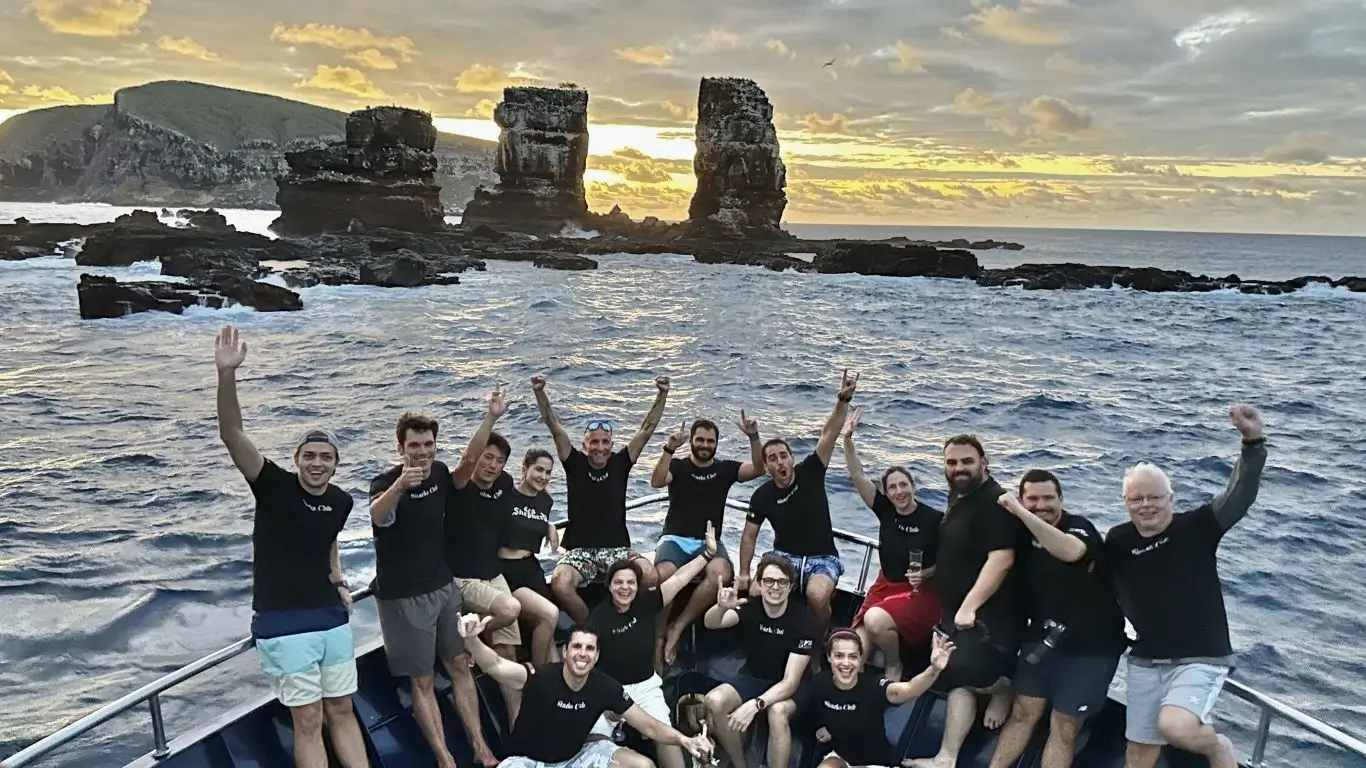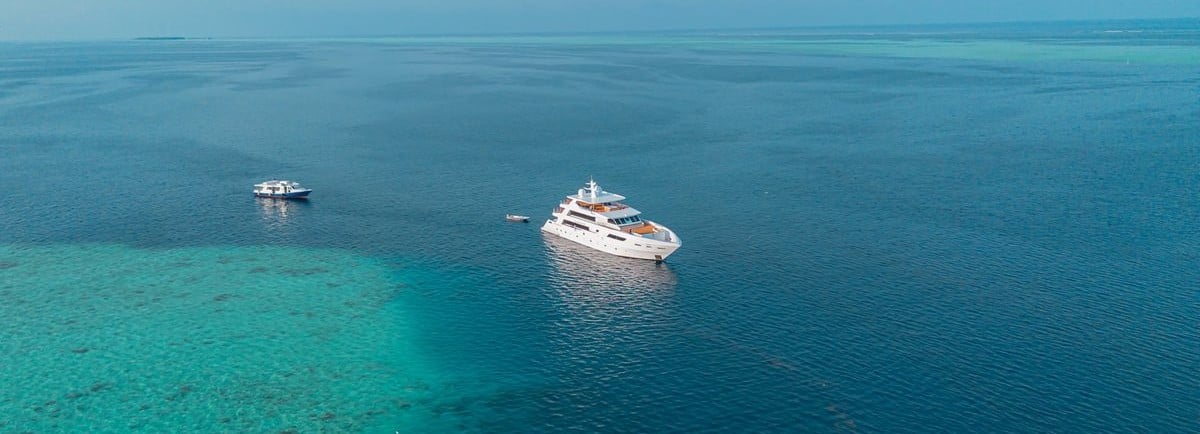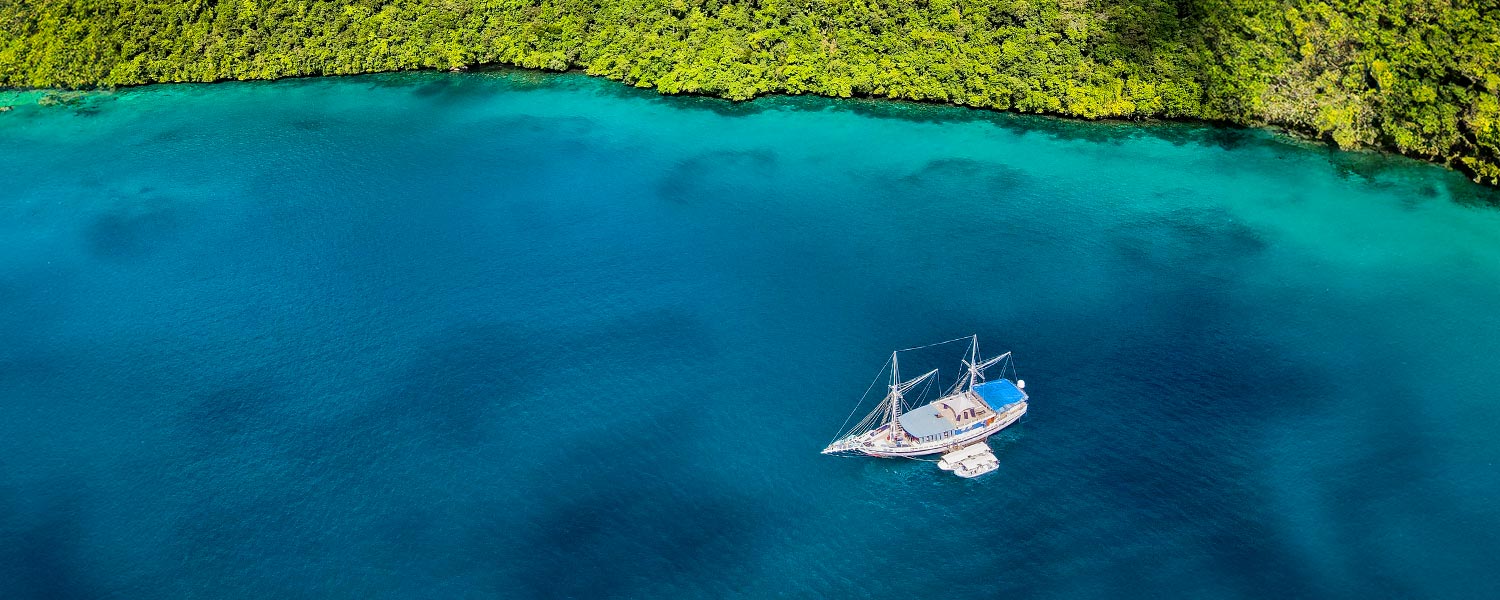I remember standing barefoot on the dive deck just before dawn, coffee in hand, watching hundreds of boobies on their morning fishing expeditions, as the first light caught the silhouette of Darwin’s Arch. Or the remaining pillars of the arch at least. This was my first time on a Galápagos liveaboard and the Pacific was still, except for the soft hum of the compressor on the dive deck and the occasional splash of a booby diving for its breakfast. The anticipation was almost tangible, it had been a long time since I was this excited for a dive! Within the hour, I’d be surrounded by hammerheads.
There’s something unique about even the feel of the Galápagos Islands: wild, remote, and unlike anywhere else on Earth. Liveaboard diving in the Galápagos Islands isn’t just a trip, it’s a full immersion into the planet’s most extraordinary marine theatre. And aboard Galapagos Master, it becomes more than an adventure. It’s a finely tuned expedition led by professionals who know every current, every swell, and every shark silhouette that passes beneath the hull.
At A Glance
- 7 nights and 10 nights available onboard the Galapagos Master
- Up to 4 dives a day at world-famous sites
- Encounters with hammerheads, whale sharks, and playful sea lions
- Water temperatures: 20–26°C (68–79°F) – though expect some cooler water in spots
- Expert guides, detailed briefings, relaxed evenings under the stars
- Life-changing diving for experienced divers and adventurers
Welcome Aboard Galapagos Master
The first thing you notice when you step aboard isn’t really the boat itself, it’s the crew. Warm smiles, handshakes, and the quiet efficiency of people who’ve done this a thousand times but still genuinely have love for it. After a quick tour and detailed boat and safety briefing, guests start to gather on the sundeck to take in that first stretch of Pacific horizon as the boat departs.
Galapagos Master is purpose-built for the conditions you are likely to expect, with a well organised dive deck, dedicated camera stations, individual rinse tanks, and comfortable cabins with sea views. The communal areas are designed for divers, with all boxes ticked: functional, relaxed, and social. Breakfast aromas drift up from the galley; wetsuits hang ready for action; and you quickly feel part of a small, tight-knit expedition team.
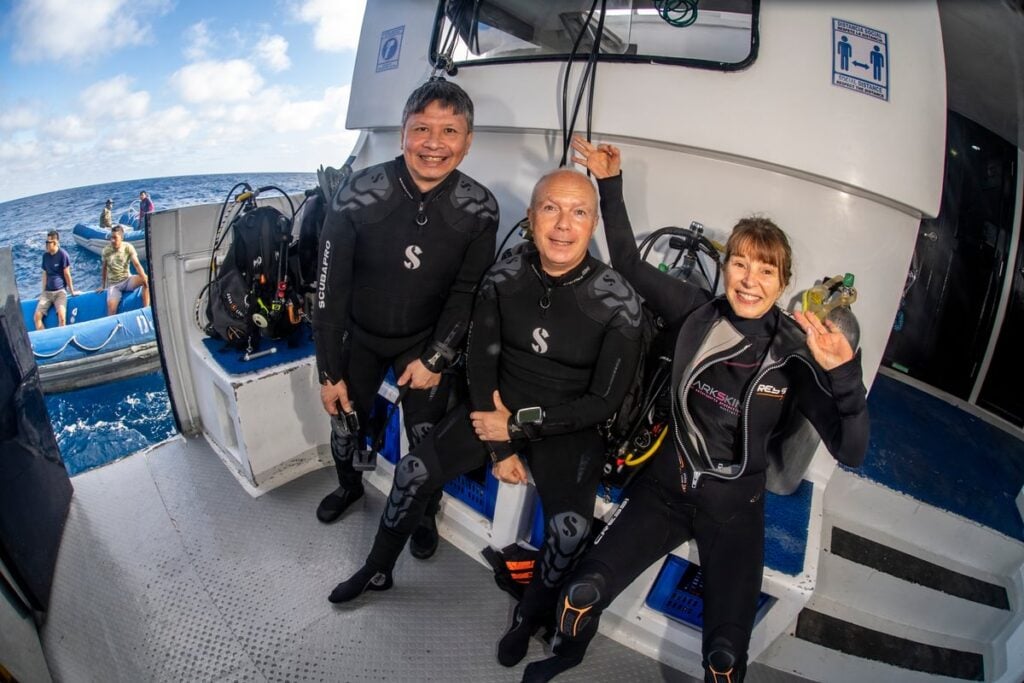
What sets Master Liveaboards apart in Galápagos isn’t just the vessel, it’s the way every detail feels tuned to divers. From the post-dive warm drinks waiting on deck to the meticulous safety culture, it’s clear this isn’t a cruise. It’s a professional dive operation that happens to deliver one of the most memorable travel experiences on the planet.
Your First Dives
Diving days start early. The crew are up before dawn, prepping gear and filling tanks. After a light breakfast and the day’s first briefing, it’s time to gear up. The first tender usually departs soon after sunrise, that golden hour when the ocean feels charged with energy.
Briefings are detailed but never overbearing, the guides here are all National Park trained, afterall. Conditions can change fast in the Galápagos, so knowing where to position yourself in the current and when to descend is critical. The guides walk through the dive plan, the expected current strength and marine life, as well as key safety procedures.
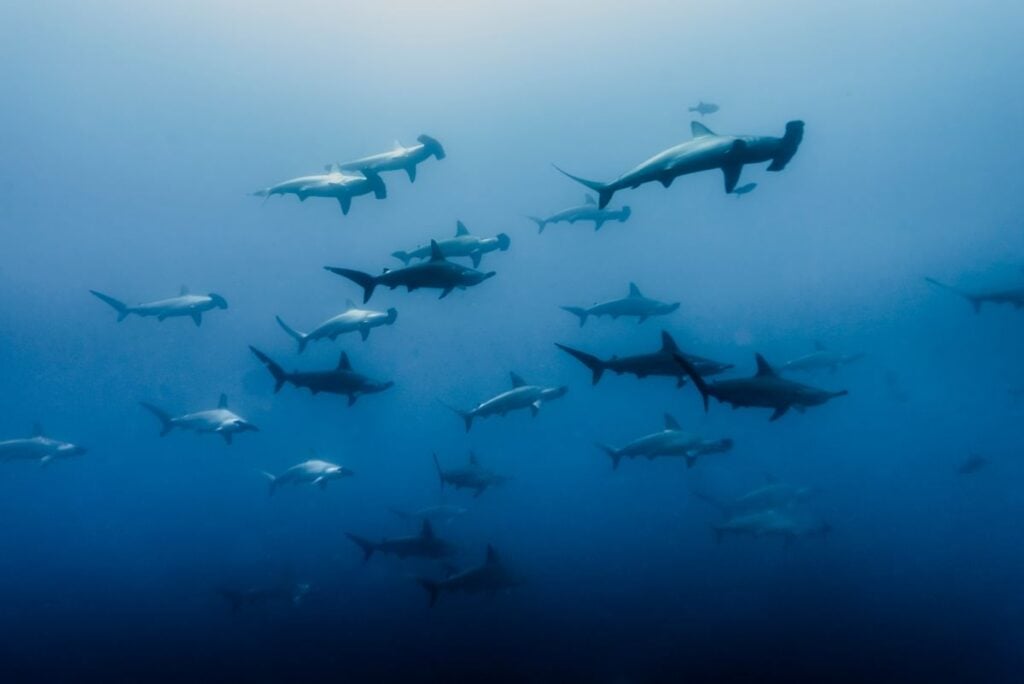
At Darwin’s Arch, you’ll likely spend time hovering mid-water, or hiding from currents behind rocks in the arena, watching schools of scalloped hammerheads form shimmering walls in the blue. At Wolf Island, hundreds of pelagic fish swirl in a vortex while sea lions dart through the chaos like acrobats. That’s before we even start to talk about mola mola at Isabela, marine iguanas at Fernandina, penguins, eagle rays… the list goes on. And on. Every dive delivers something unforgettable; it’s that simple.
Typical dive conditions:
- Temperature: 20–26°C (68–79°F)
- Visibility: 10–25 metres
- Currents: Moderate to strong, which is part of the magic… and the challenge
Galápagos is not beginner territory. All divers here aboard Galapagos Master must hold an Advanced Open Water certification or higher, and be comfortable in currents. But the payoff? Extraordinary encounters that make every pre-dive check and safety briefing worthwhile.
Life Between Dives
Once the gear’s rinsed and tanks are refilled, life transforms into the dive, eat, sleep rotation. The morning buzz settles and a kind of easy camaraderie begins to grow. Divers compare photos and video footage over hot chocolate and coffee, others sprawl out in the sun. But someone’s always scanning the horizon for an orca or dolphins.
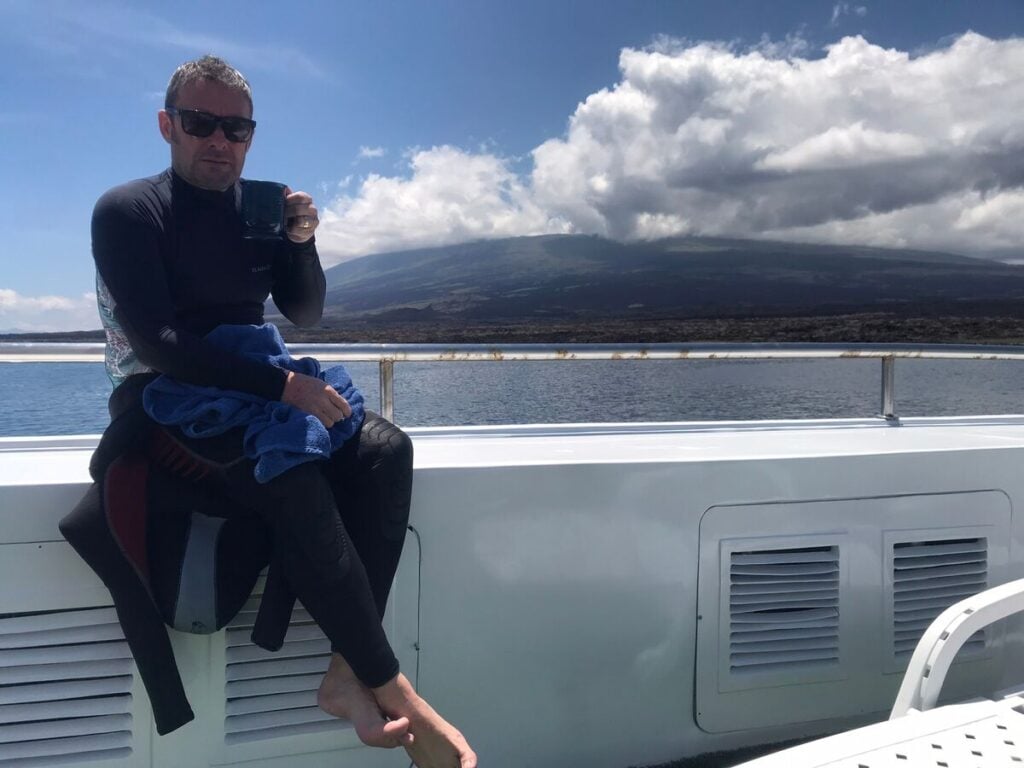
Between dives, Galapagos Master hums with quiet energy. The crew are efficient but relaxed, always ready with snacks, warm towels, or a bit of local insight. The guides share stories about the islands, the mating rituals of frigatebirds, the volcanic origins of the islands, and soon, you realise this is as much a learning experience as it is a dive trip.
“You’ll come for the hammerheads,” one guide jokes, “but you’ll stay for the coffee and the naps.”
Dive Conditions and Preparation
Diving the Galápagos Islands demands respect and the right preparation. Conditions can vary widely between dive sites, and currents are what make the region so spectacular. So you need to be ready before you hit the water. Here’s what to know before you go:
What to Expect
- Water temperature: Average temps vary through the year between 20 and 26°C (68–79°F)… but always expect cooler water around Isabela.
- Visibility: Usually 10m to 25m depending on the site.
- Currents: Moderate to strong, sometimes upwelling and potentially very changeable.
- Depth: Typical profiles range between 15m and 30m. You don’t need to go deep here!
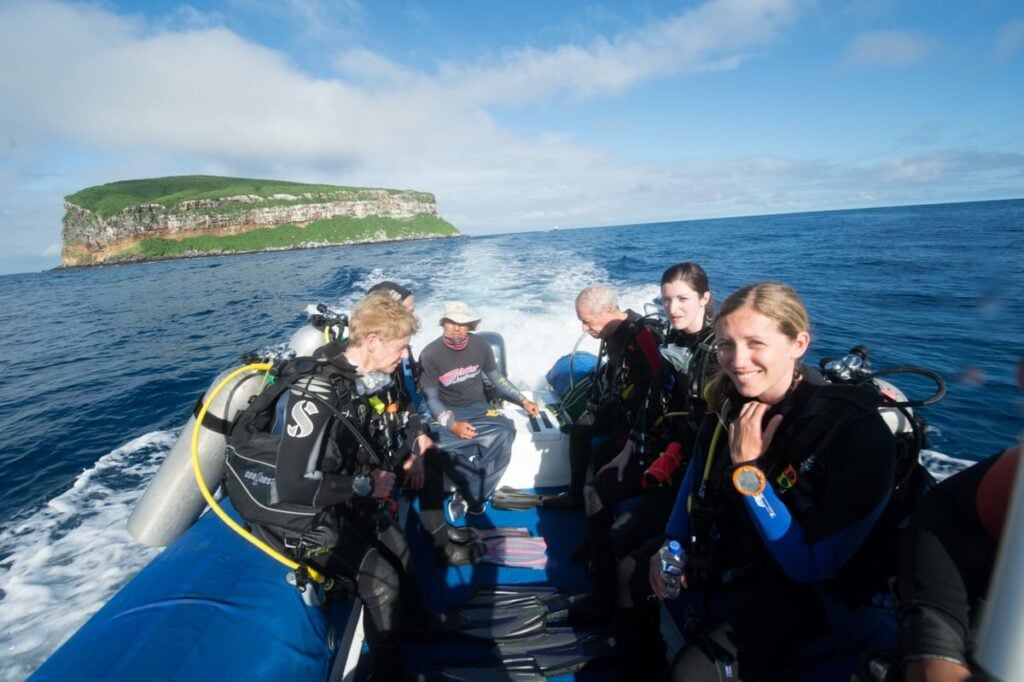
Gear and Tips
- Wetsuit: 5mm – 7mm full suit is recommended (bring a hooded vest for cooler dives or if you feel the chill).
- Reef hooks: Useful for holding position in current, generally only around Darwin’s Arch.
- Gloves: Optional but handy for rocky holds and for those who feel the cold more.
- Camera gear: Wide angle is the way to go, ensure you attach to yourself on dives.
- Seasickness tablets: Always advisable to those who do not travel often on boats, but especially here. The crossing to Darwin and Wolf can get lively.
Galapagos Master provides weights, tanks, and Nitrox for certified divers. All you need is your personal kit, certification card, and a healthy respect for the currents.
Evenings Onboard
After the last dive of the day, the already steady rhythm slows further. The sunset turns the ocean gold as divers gather on the upper deck, swapping stories over cold drinks and the odd cocktail. Dinner is served family-style with hearty meals of local fare. There will be laughter and the satisfying fatigue that only comes from a full day of diving!
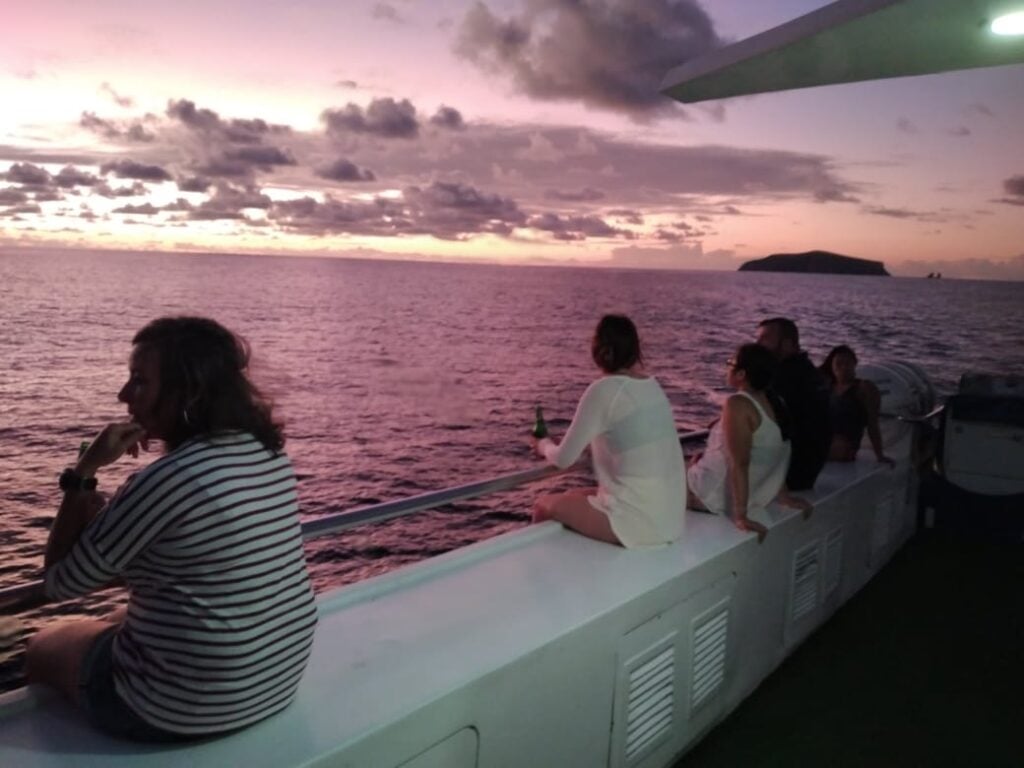
There are no night dives here and so evenings on Galapagos Master are about connection. Some guests review footage, others chat with guides about marine life identification, and occasionally someone will pull the guitar off the wall. This sense of community builds naturally on liveaboards, a group of strangers becoming friends, bonded by their love of the underwater world.
Later, under a sky blazing with stars brighter than most are used to, you might find yourself reflecting on what you’ve experienced. Few places on Earth make you feel so small, so alive, and so grateful to be part of it.
Why Choose Galapagos Master
There are plenty of liveaboards operating in the Pacific, but few match Galápagos Master for professionalism, safety, and sheer passion for diving. All crew members, from the captain to the compressor tech, are Galapagueños first. That shared understanding and love of their home runs through every part of the operation.
The vessel itself is modern, stable, and designed by divers for divers. The crew is one of the best in the region, and the attention to maintenance and safety is exemplary. But what really makes the difference is the commitment to making every guest feel part of the team.
When you sail with Master Liveaboards, you’re not just booking a trip, you’re joining a community of ocean enthusiasts who care deeply about the places they visit and the people they share them with.
Frequently Asked Questions
As there are no night dives it is usually three but certain days can provide four dives, depending on conditions and the general itinerary.
There is no ‘best’ time as diving is possible year-round and the diving is always amazing. But… June to November offers cooler water with the pay off of regular big pelagic encounters (whale sharks, manta). December–May brings warmer water, calmer seas, and better visibility. Hammerheads can be seen year round.
Master Liveaboards requires minimum Advanced Open Water certification with 50+ logged dives. Comfort in currents is essential.
Expect hammerheads, whale sharks (in season), Galápagos sharks, marine iguanas, mola mola, eagle rays, turtles, sea lions, and dense schools of jacks and barracuda.
Ready to Dive In?
The Galápagos has a way of changing your perspective on life above and below the surface. It strips away the noise and reminds you why you fell in love with diving in the first place. Every dive is a privilege, every moment on deck a reminder of how wild and wondrous our oceans still are.
When you’re ready to experience the world’s most thrilling diving and to join a crew that feels like family, Galápagos Master is waiting.
Mik Jennings
